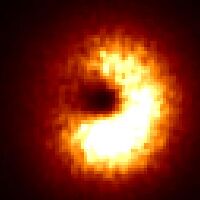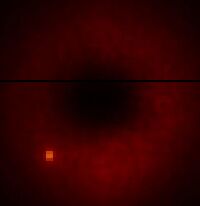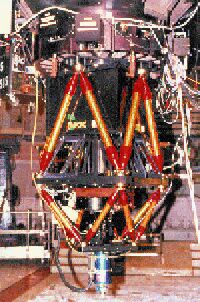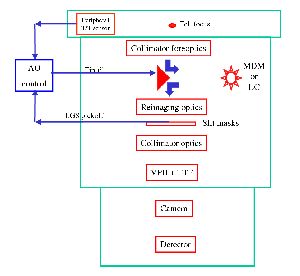-
Bacon (Lyon): OASIS — an Adaptive
Optics (AO) optimised integral field spectrograph.
-
Doel (UCL, London): Coronagraph for
the NAOMI AO system.
-
Sharples (Durham): MOSAIC — Multi-Object
Spectrograph with Adaptive Optics Image Correction.
- Vick (ATC, Edinburgh): High-resolution spectral imaging facility for the NAOMI AO system.
| THE ING NEWSLETTER | No. 2, March 2000 |
|
|
SCIENCE |
|
|
|
| Previous: | WHT Millenium Upgrade | Up: | Table of Contents | Next: | The New WHT Mosaic Camera |
Other available formats: PDF | gzipped Postscript
New Instrumentation for the WHT
René Rutten
(Director ING)
In order for the William Herschel
Telescope to keep offering the best possible instrumentation in the future,
it is important that new ideas and instruments are developed. For that
reason, in June 1999 an announcement was sent out inviting novel ideas
for new instrumentation for the WHT to be brought forward. The following
four proposals for new instruments were received:
Each of these proposals was
of high quality, which made it difficult to set priorities. It is noteworthy
that all four proposals focus on adaptive optics, which is conceived as
a key development area for the WHT.
Following a review by the Instrumentation Working Group (IWG) the ING Board discussed the various submissions and recommendations in December 1999, and I will present here what the outcome was.
The ING Board considered that
the proposal by Doel et al. to build a coronagraphic unit to work with
NAOMI should be supported on the shortest possible time scale. Examples
of science areas where the coronagraph would be particularly useful are
the study of brown dwarfs and substellar companions, proto-planetary disks
around young stellar objects, QSO host galaxies, and mass outflow from
objects such as symbiotic stars and luminous blue variables.
 |
 |
| Figure 1. Simulated H-band coronagraphic PSFs with a secondary star 1.0 arcsec away from the central object (delta m= 7 m) without (left) and with adaptive optics correction (right). The diameter of the focal plane stop was 1.0 arcsec and the uncorrected seeing was ~0.7 arcsec. [ JPEG | TIFF 1 | JPEG | TIFF 2 ] | |
This development has a clear set of science applications and can be delivered at a modest cost. This instrument would be able to exploit the capability of NAOMI with natural guide stars, as it will be used in the investigation of faint sources around bright objects. It would help increase the early scientific impact of NAOMI.
The proposal by Bacon et al. to deploy an existing instrument, OASIS (currently available on the CFHT) on the WHT with NAOMI was considered extremely attractive. OASIS is a state-of-the-art and unique integral field spectrograph using a lenslet array. Its design allows very fine spatial sampling to take full advantage of an Adaptive Optics system. The instrument is fully developed and operational, but would have to be adapted to work with NAOMI. An assessment is being undertaken to see whether both systems can be made compatible.
OASIS is a versatile spectrograph allowing a wide range of science projects to be carried out, and therefore it is anticipated that the interest in its exploitation will be large.
The MOSAIC proposal by Sharples is for an AO-corrected multi-object spectrograph and imager for the WHT Nasmyth focus. This system is distinct from the NAOMI AO system and would have its own (restricted conjugate) AO system, which aims to achieve not so much the best possible image quality over a small field, but instead aims for significant improvements in image quality over a wide field. The AO feature in combination with a multi-object spectrograph would present important gains over existing facilities, and be unique.
MOSAIC would have an important impact on the WHT. It would be mounted at the Nasmyth focus where currently UES is mounted. (UES would have to be positioning elsewhere and fed by a fibre from MOSAIC). The AO correction would also involve installing a Rayleigh laser system to generate the artificial guide star.
Clearly this instrument would
have great potential and potentially keep the WHT competitive next to the
8-m class telescopes. MOSAIC, with its laser system and own AO hardware
is a comparatively complex instrument that would require a major investment.
Technical and performance aspects, as well as its impact on telescopes
operation will need to be studied further.
 |
 |
|
|
|
LDSS and TAURUS on the WHT
A second announcement-of-opportunity was issued also in June 1999 asking interested parties to adopt the existing common-user instruments: the Low Dispersion Survey Spectrograph, LDSS, and the Fabry-Perot imaging spectrograph, TAURUS, as private instruments.
The reason to retire these less-used instruments as common-user facilities was driven by a combination of financial and operational pressures. Rather than just decommissioning the instruments they were offered to interested groups in the user community to take on as private instruments. In this way the instruments could be retained for the continued use by the astronomical community, but no longer be a burden on the observatory, which is faced to have to take care of a growing number of instruments under ever tighter financial constraints.
Four proposals were received as
a result of this announcement. The proposal by Richard Bower (Durham) to
adopt LDSS and by Richard McMahon (Cambridge) to adopt TAURUS were considered
the strongest on the basis of their science case and ideas for developing
the instruments further. The ING Board decided that these instruments would
transfer to Durham and Cambridge respectively as private instruments. Both
PIs indicated the possibility that the instrument may be used on other
telescopes in the future. Both proposers also indicated interest in collaborating
with other groups on future use of the instruments. Therefore from now
on anyone interested in using either LDSS or TAURUS should contact Richard
Bower or Richard McMahon, respectively.
Email contact: René Rutten (rgmr@ing.iac.es)
| Previous: | WHT Millenium Upgrade | Up: | Table of Contents | Next: | The New WHT Mosaic Camera |
| GENERAL | SCIENCE | TELESCOPES AND INSTRUMENTATION | OTHER NEWS FROM ING | TELESCOPE TIME |